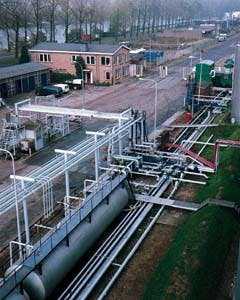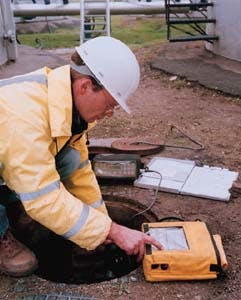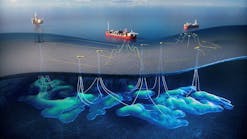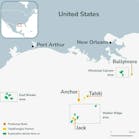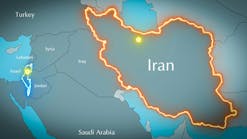BP Nederland's Nijmegen petroleum products storage site. Remediation equipment is housed in green containers at upper right, opposite the site office. In inset at right, a Groundwater Technology employee collects performance data from an air injection well. Photo courtesy of BP Nederland.
BP Nederland BV is 6 months into an unusual program of soil decontamination at its Nijmegen, Netherlands, oil storage depot.
The program is expected to require 2-3 years and cost DFl 4 million ($2.5 million).
Remediation work is being carried out by Groundwater Technology BV, Rotterdam, by means of soil venting and sparging. This is said to be cheaper than soil excavation and has environmental advantages over other techniques.
The technique
The sparge and vent system involves creation of an air flow into groundwater saturated soils by injection of compressed air. Air extraction creates a flow in the soil above groundwater level.
Injection of air into the groundwater zone provides oxygen to enable bacteria in the soil to break down contaminants. Above groundwater level, removed air carries volatile organic compounds out of the soil for treatment.
Wells and pipes for sparging and air venting were installed during December 1994-February 1995. Surface equipment was completed in June 1995.
While venting and sparging has been applied before, the Nijmegen project is said to be the first in Netherlands in which decontamination is performed without using groundwater to wash out waste oils.
Once BP decided that soil decontamination was needed, the company hired Groundwater Technology to determine whether any method besides earth removal was feasible. BP hoped to keep the site in operation while remediation was in progress.
Groundwater Technology found that the site was polluted mainly by gasoline, diesel fuel, and fuel oil.
Because the depot lies on highly permeable sandy soil, the contractor concluded that on-site biological degradation and volatilization of the contaminated soil was feasible.
Lack of oxygen in the soil was an obstacle to biodegradation, but Groundwater Technology said extracting air from the soil and injecting compressed air would overcome the shortage.
The early study also showed that leaked gasoline was floating on groundwater in the depot, but this could be removed by extracting air from the soil.
The gasoline layer was removed during May and December 1994, ahead of the main decontamination process. Then a trial of the main process on a 150 sq m area of the site was carried out as a prelude to gaining approval for the process from authorities.
"Lowering of the groundwater table is a major issue in Holland," said Yvo Veenis, project director at Groundwater Technology. "Agriculture and industry have been using too much groundwater, creating drought conditions."
Veenis said typical soil decontamination involves flushing out contaminated groundwater with uncontaminated groundwater from another site. This requires 30-50 units of clean water for every unit of contaminated water.
"Another drawback of using groundwater here," Veenis said, "is that waste water could not be discharged into local canal water, while water treatment is very expensive and would require bulky hardware in an already cramped site."
Progress report
BP said, "Thus far, some 50,000 kg of oil has been removed from the land. Approximately 70% of this has been extracted in gas form and 30% has been consumed by bacteria in the soil."
The amount of decontamination by bacteria is expected to increase as the project progresses. Volatile compounds are extracted quickly, while biodegradation take more time.
BP said a measurement taken last Jan. 10 clearly shows the scope and concentration of contamination have decreased. Average concentration has dropped 65%.
It is not possible to place a figure on how much pollutants are in the soil at the Nijmegen depot, Veenis said. However, he expects the soil's aromatics content to be reduced to single figure parts per billion, while mineral oils content will be reduced to 10-20 ppb.
Veenis said it will take about 2 years to clean up most of the Nijmegen site.
"We usually find there are a few hot spots that are more difficult to remediate, so we budgeted another year for this."
Copyright 1996 Oil & Gas Journal. All Rights Reserved.
